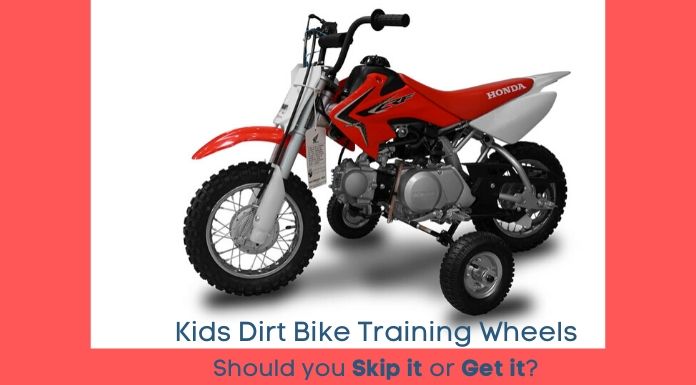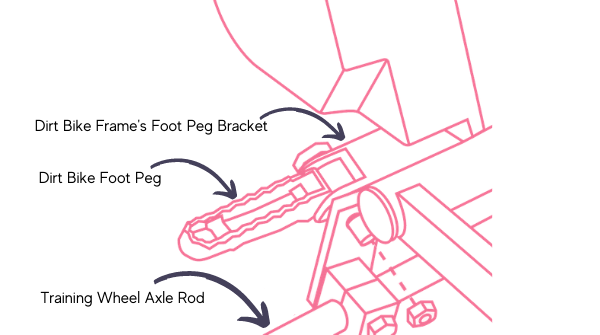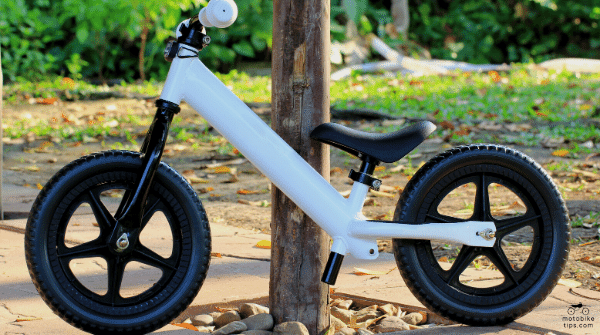You may be able to skip it if your child has ridden a bicycle or balance bike. However, depending on your child’s age, height, and confidence level, dirt bike training wheels may be helpful.
While training wheels can provide some parents (and kids) peace of mind, others argue that they are not productive to children’s learning experience. In this article, we will discuss both the benefits and the drawbacks of using them.
A quick note that we are talking about real dirt bikes here. They are made for kids’ gas-powered 50cc motorcycles like the Yamaha PW50 or electric dirt bikes like the one from Razor.
“The key here is not the pedaling of the bicycle but knowing how to balance a 2 wheeler and steer it by leaning using child’s own weight!”
Motobiketips.com

A Quick Summary
Here are the key highlights from this post:
- They work like training wheels on a bicycle but fits in the middle of the frame
- They can help 3 – 5 year olds or shorter kids learn to ride without intimidating them
- Most dirt bike manufacturers don’t build or sell them but you can buy from accessory sellers
- Universal training wheels can fit most mini gas and electric dirt bikes, but it’s best to check with the manufacturer before you purchase one
- Whether you use them or not, adult supervision is always required for your child’s safety
- If your child doesn’t know how to ride a regular pedal bike or a balance bike, then consider delaying the dirt bike.
- The best approach is to get a balance bike first, then graduate to a pedal bike and finally a dirt bike, without any training wheels
In this article, you will learn:
- How do they fit on the dirt bike?
- What are the pros and cons of getting them?
- What are the other alternatives?
- What are the 3 ways to get it?
Ready? Let’s get right into it…
How do they Fit?
It’s a simple concept and works just like training wheels on a regular pedal bike (bicycle). However, it’s fitted in the middle portion under the dirt bike, not on the rear wheel like the regular bike.
So, instead of 2 separate L-shaped training wheel assembly that goes on either side of the bicycle’s rear wheel, the dirt bike training wheel is 1 assembled unit with a wide axle rod running under the dirt bike’s frame with a training wheel at each end.
Depending on your dirt bike’s make/model and the training wheel kit you buy, it can fit the frame’s footpeg brackets. The illustration below shows a 50cc dirt bike with training wheels or an electric dirt bike with training wheels being installed to the frame’s footpeg bracket.
More on the installation in a minute. You can watch the complete installation video below in the section “How to install a dirt bike training wheel?”.

Some parents use it for balance support for little kids (3-5 years) whose feet may not even touch the ground when mounted on a dirt bike. Others with kids between 5-8 years, whose feet touch the ground firmly, use it to make their kids feel comfortable on a dirt bike.
Either way, the idea is to reassure their newbie junior rider that they won’t fall off the dirt bike.
Pro Tip: Although some 3-year-olds can ride a 50 cc gas-powered or a real electric dirt bike, parents should consider their own kid’s age, size, ability, and maturity before allowing them to ride. Every child is different and can learn to ride at a later age, which is perfectly fine!
Pros and Cons of Training Wheels
The Pros
Encouragement: The idea of having training wheels can encourage both parents and beginner youth riders to try out riding a dirt bike. They will feel secure while riding.
Confidence: By minimizing the risk of falling off the dirt bike in the early stages of the learning journey, the most important benefit it can provide is to build a newbie’s confidence. Little riders also feel more independent when they can ride on their own.
Learn Controls Quickly: It allows beginner riders to focus on the controls – acceleration, shifting gears, and breaking. However, it defers their “real world” balancing experience to a later stage when they would eventually ride without training wheels.
The Cons
Safety: Some safety concerns as the training wheel kit is not an integral part of the dirt bike’s frame, but rather an extension sticking out on both sides of the bike. So there are now four wheels on the ground that need to be kept in mind.
In a rear occurrence where kids may ride over an object with only one training wheel, it can cause the dismounting of the rider or damage your bike or the training wheel assembly.
Balance: By creating a support system for balance, training wheels can create a false understanding of balance. The goal of having training wheels is to support kids while they learn to throttle, brake, etc. When removed, kids may not be able to balance independently. Dirt bike training wheels can encourage kids to become over-reliant on them.
Also, we know at very low speed the training wheel provides assisted balance. This can be misleading to the newbie junior rider making them think they can go at a low speed without losing balance.
Steering: While cornering training wheels bear the most weight and hold the bike upright. Dirt bikes steer by leaning and training wheels can become a barrier to this natural lean.
Quality, Weight, Costs: Most after-market training wheels for dirt bikes are not good quality. They’re flimsy and can bend. They also added extra weight and costs. A good quality training wheel kit is not cheap. They can cost around $100 or more.
Alternatives to Training Wheels on Dirt Bike?
The short answer is it depends on where your kids are on their two-wheeler riding journey. With two-wheelers here, we mean do they have any experience riding a regular pedal bike or a balance bike? Many parents believe in the gradual learning of crawl, walk, run, balance bike, bicycle, and then the dirt bike.
Kids, youth, or children in general who already know how to ride a regular pedal bike (a bicycle) or a balance bike can skip the training wheels – unless their feet do not properly touch the ground when mounted on a small dirt bike.
For kids who can’t ride a bicycle, you can even start them off with a balance bike. Some balance bikes cost the same or even less than the training wheel kit for dirt bikes. They are great starter bikes for kids of all ages and come in different sizes. It teaches them how to balance and steer by leaning when making turns.
Electric Balance Bike
You can also opt for a Harley-Davidson electric balance bike (previously known as StaCyc) at half the cost of a dirt bike. This can be a great stepping stone to a dirt bike, but these can go fast.
Once they are comfortable with the balance bike (or a bicycle), they can graduate to a small 50 cc dirt bike or an electric dirt bike, without any training wheels. Parents can even skip teaching them to ride a bicycle. But, knowing how to ride a bicycle is helpful. Plus, who wants to miss the fun of riding a bicycle?
Dirt bikes are not like a bicycle that requires a huge effort on the pedals to move the bike. Throttles on dirt bikes that control acceleration are much easier to learn compared to pedaling the bicycle.
Some 50 cc dirt bikes such as the Honda CRF50F have a throttle limiter so you control how much power it puts out. Even though it has a 3-speed transmission and uses an automatic clutch, you can limit the throttle for low speeds and let them ride in 1st gear only, at least for the initial rides. You can delay teaching them gear shift for a bit.
“Almost all professional dirt bike training programs for kids don’t use training wheels and require kids to be able to ride a bicycle.
motobiketips.com
The key is not the pedaling of the bicycle but knowing how to balance a 2-wheeler and steer it by leaning with the child’s own body weight!”
3 Ways to Get Training Wheels
Option 1: Buy a Dirt Bike with Training wheels
First, consider buying a dirt bike that comes with a training wheel, if you haven’t bought the bike yet. The training wheel from the bike manufacturer would fit the best as it’s specifically designed, built, and tested for that particular dirt bike. So, check with your dirt bike dealer or manufacturer.
However, most dirt bike manufacturers don’t make training wheels. There is a good chance that your dirt bike brand may not make them. If that’s the case, then option 2 may be for you.
Option 2: Buy Universal Training Wheel Kit
There are companies other than your dirt bike manufacturer who make dirt bike parts and accessories. These are often referred to as aftermarket parts. The most popular brand that makes the best one is “Hardline Products’ ‘ (Note: we’re not affiliated with them but know they make the best ones).
They make a “Universal Training Wheel kit”, which means it can fit most mini dirt bikes. You should check with them if it would fit your particular dirt bike’s make and model.
How to Install?
Here’s a short video on how you can install training wheels on a small electric dirt bike Razor MX350. As they’re universal, they can be installed on other popular models such as Honda 50 cc dirt bikes or the Yamaha TTR50, KTM SX Mini 50, Suzuki DRZ-50, KTX, etc. They can also be installed on electric dirt bikes such as the OSET or the Kuberg, or other Razor models, etc.
Option 3: Build the Training Wheel Assembly [not for everyone!]
If you’re a handyman type of person and feel confident about building one, you can make a training wheel yourself. But, keep safety in mind first. You wouldn’t want one of the wheels or the nuts and bolts to come off or get a thin axle rod that can easily bend.
It should function and fit well on your particular dirt bike. It should also be strong enough to support the dirt bike’s weight.
Not everyone can do it as building one as a DIY project involves some technical know-how of metals and their strength, some welding of parts, getting the right fasteners (the nuts and bolts), the right size of the wheels with the tires, etc.
Final Thoughts

Training wheels for dirt bikes are more about making the junior newbie rider feel comfortable and secure. It may help the rider quickly learn the controls but will defer the learning of how to balance the dirt bike. Children who have experience riding a bicycle or a balance bike may not require training wheels at all unless their feet don’t touch the ground properly when mounted on the dirt bike.
Parents should consider a balance bike as a building block that can help kids learn how to balance a 2-wheeler. A balanced bike can help avoid training wheels on both, bicycles and dirt bikes.
Balance bikes can cost the same or less than a good training wheel kit for dirt bikes. Plus, you can teach younger siblings later.
If you determine that your kids absolutely need the training wheels to get started, then try to buy one from your dirt bike manufacturer or dealer, otherwise, get a Universal Training Wheel kit made by Hardline Products. Again, we’re not affiliated with them just recommending the best.
Finally, you can consider building a training wheel assembly but not everyone can do that, as it may get somewhat challenging. But, there may be some safety risks if it’s not built or tested properly.
As parents, you can decide what’s the best training approach for your child. At the end of the day, it’s about knowing their abilities, training effectively, and making it fun!

